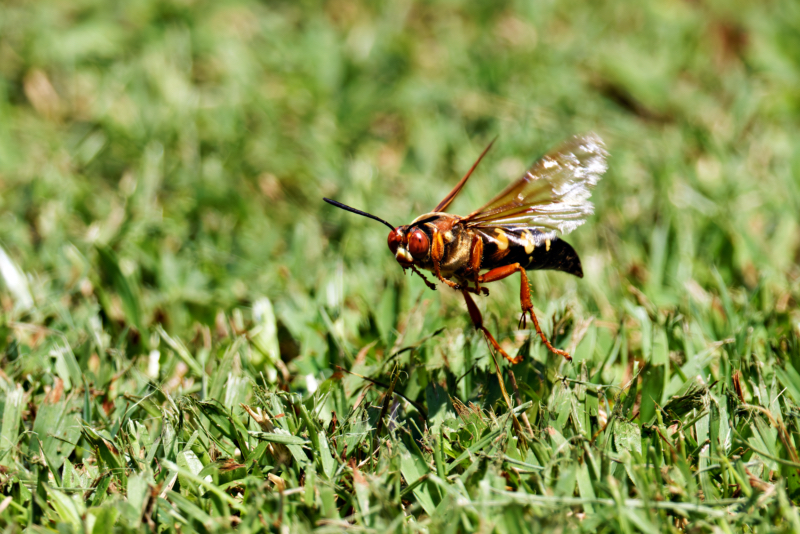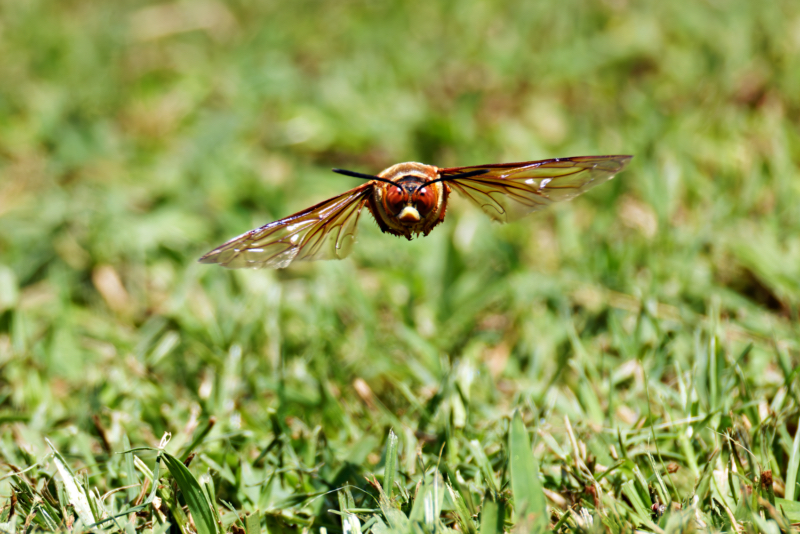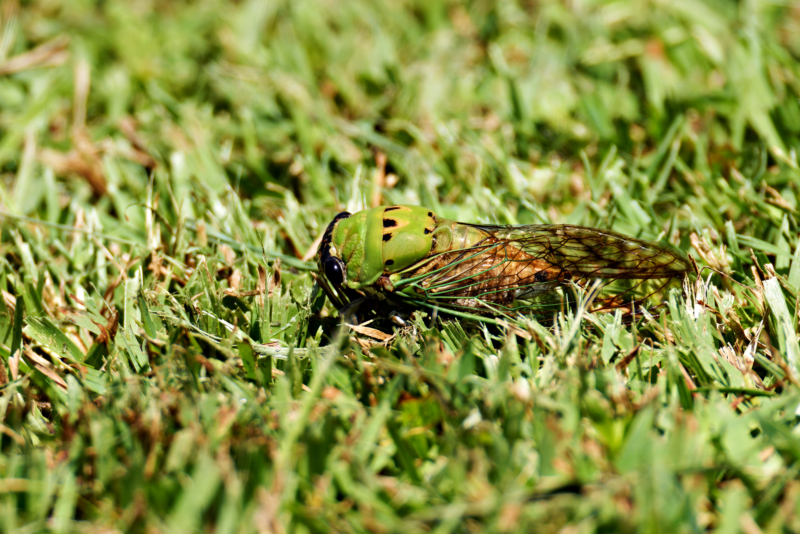On August 5th, while I was mowing my yard, I spotted a large Eastern Cicada Killer Wasp flying low over an area I had just mowed. Having seen these wasps in my yard over the years, I immediately recognized it. I was certain it had a burrow nearby. A few minutes later, I saw another one flying with a cicada. It dropped onto the grass, but when I walked over to locate it, I couldn’t find it. A few minutes later, I saw one dragging a cicada across the grass. When I approached, it abandoned the cicada and flew away.
Determined to photograph this fascinating insect, I grabbed my camera and waited in the area. The wasp returned but not to retrieve the cicada. Instead, it went in and out of a burrow in the ground nearby. I began photographing it as it flew low over the grass, hoping it would eventually bring a cicada to the burrow, but it didn’t.



Fascinating Facts About the Eastern Cicada Killer Wasp
Physical Characteristics
- Size and Appearance: These wasps are quite large, with females reaching up to 2 inches in length. They have black bodies with yellow markings on their abdomen and reddish wings.
- Sexual Dimorphism: Males are significantly smaller than females and lack stingers, while females have stingers but are not aggressive.
Behavior and Ecology
- Solitary Nature: Unlike social wasps, Eastern Cicada Killers are solitary. Each female digs her own burrow and provisions it with paralyzed cicadas for her larvae.
- Burrowing Habits: Females dig extensive underground burrows, which can be up to 70 inches long and 15 inches deep. These burrows often have a distinctive U-shaped collar of loose soil around the entrance.
- Lifecycle: The wasp’s lifecycle begins with the female laying an egg on a paralyzed cicada. The larva hatches, consumes the cicada, and overwinters in a cocoon before emerging as an adult the following summer.
Reproductive Behavior
- Paralyzing Prey: Female cicada killers paralyze cicadas with a venomous sting and transport them to their burrows. This is an impressive feat given that cicadas can be as large or larger than the wasps themselves.
- Sex Determination: Female cicada killers can predetermine the sex of their offspring. This is essential for maintaining the population, as more females are needed to ensure future generations.
Interactions with Humans and Other Animals
- Non-Aggressive Nature: Despite their intimidating size, Eastern Cicada Killer Wasps are not aggressive towards humans. Females will sting only if directly handled, and males, while territorial, cannot sting at all.
- Panic Induction: Their large size and buzzing can cause fear among people, but they pose little actual threat unless provoked.
- Predators: Skunks and other animals may dig up burrows to feed on the larvae and paralyzed cicadas.
Habitat Preferences
- Preferred Locations: These wasps favor well-drained, light-textured soils in sunny areas near trees that harbor cicadas. Common nesting sites include lawns, gardens, and edges of sidewalks or patios.
- Population Dynamics: Large aggregations can form over time as new generations emerge and burrow in the same area, potentially causing unsightly soil mounds.
Diet
- Larvae Diet: The larvae feed exclusively on cicadas provided by the female wasp.
- Adult Diet: Adult cicada killers feed on flower nectar, tree sap, and other plant exudates.
These unique characteristics make the Eastern Cicada Killer Wasp a remarkable and often misunderstood insect. While their presence can be startling, understanding their behavior and ecology can help mitigate unnecessary fear and appreciate their role in the ecosystem.
My backyard encounter with the Eastern Cicada Killer Wasp was a reminder of the complex and fascinating natural world that exists right outside our doors. It’s experiences like these that encourage us to observe, learn, and appreciate the diverse wildlife that shares our living spaces.
Steve Creek
For more detailed information, check out these resources:
University of Kentucky Entomology
Cicada Mania
Purdue Extension Entomology

Fascinating, I had no idea these wasps existed. Must confess that getting coming that close to a 2″ long wasp, my first thought would not be “quick, take a photo”!